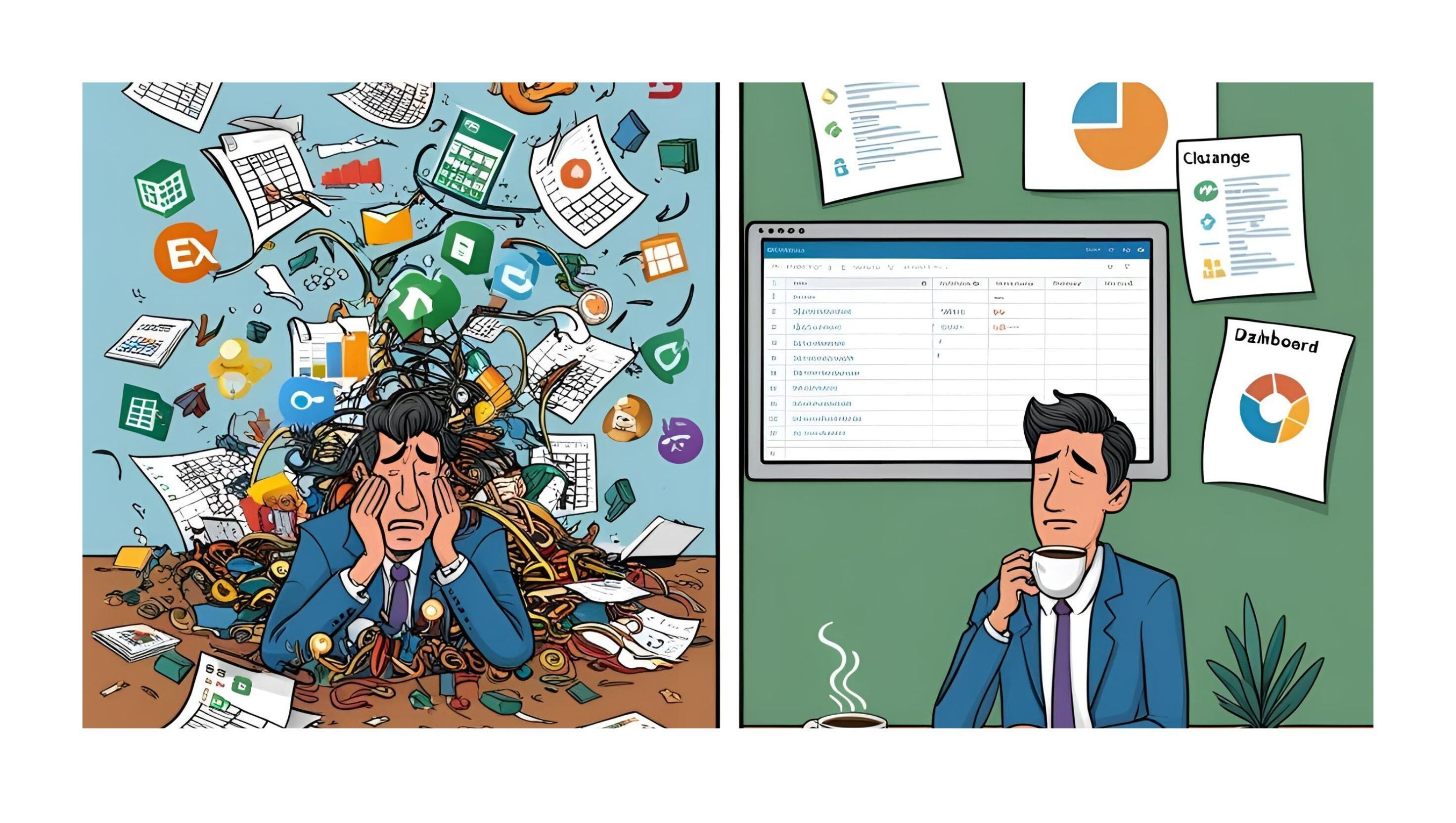Choosing the Right Data Tool: A No-Nonsense Guide for Data Consultants
As a data consultant, choosing the right tool can mean the difference between spending hours wrestling with spreadsheets or delivering insights to clients in minutes. With so many options— Excel, Power BI, Tableau, Python, and newer AI-driven solutions —how do you decide which is best for your needs?

As a data consultant, choosing the right tool can mean the difference between spending hours wrestling with spreadsheets or delivering insights to clients in minutes. With so many options—Excel, Power BI, Tableau, Python, and newer AI-driven solutions—how do you decide which is best for your needs?
In this guide, we'll break down the pros and cons of five popular data analysis tools, rating them across cost, ease of use, implementation time, and flexibility.
1. Excel: The Familiar Workhorse
Best for: Consultants who work with small datasets and need quick calculations.
| Category | Rating |
|---|---|
| Cost | ⭐⭐⭐⭐⭐ (Most affordable, included in Microsoft Office) |
| Ease of Use | ⭐⭐⭐⭐ (Familiar but formula-heavy for advanced tasks) |
| Implementation | ⭐⭐⭐⭐⭐ (Instant, no setup required) |
| Flexibility | ⭐⭐ (Good for small data, but struggles with large datasets) |
✅ Pros:
- Almost everyone knows how to use it
- Great for quick calculations and basic reports
- No additional cost if you already have Office
❌ Cons:
- Not built for handling large datasets
- No automation—manual work required for updates
- Advanced functions (macros, pivot tables, Power Query) have a learning curve
Verdict: Best for consultants handling small datasets, but struggle with scale.
2. Power BI: A Budget-Friendly BI Solution
Best for: Consultants working with structured business data who need visual dashboards.
| Category | Rating |
|---|---|
| Cost | ⭐⭐⭐⭐ ($14–$24/user per month, cheaper than Tableau) |
| Ease of Use | ⭐⭐ (Requires learning DAX and Power Query) |
| Implementation | ⭐⭐ (Setup required, not plug-and-play) |
| Flexibility | ⭐⭐⭐ (Good for dashboards but not ad-hoc analysis) |
✅ Pros:
- Great for interactive dashboards and client reporting
- Microsoft ecosystem integration (Excel, Azure, etc.)
- Cheaper than Tableau for similar functionality
❌ Cons:
- Requires learning DAX and Power Query, which have steep learning curves
- Not ideal for messy/unstructured data
- Needs a dedicated setup and ongoing management
Verdict: Good for consultants focused on visual reporting but requires effort to master.
3. Tableau: Powerful but Pricey
Best for: Consultants who need advanced visual analytics and work with large datasets.
| Category | Rating |
|---|---|
| Cost | ⭐⭐ ($70/user per month, expensive for solo consultants) |
| Ease of Use | ⭐⭐ (Intuitive visuals but complex setup) |
| Implementation | ⭐ (Requires dedicated installation and training) |
| Flexibility | ⭐⭐⭐⭐ (Great for dashboards but rigid in ad-hoc analysis) |
✅ Pros:
- Best-in-class visualizations and data storytelling
- Can handle large datasets better than Excel or Power BI
- Drag-and-drop interface (once you learn it)
❌ Cons:
- Expensive, especially for independent consultants
- Steep learning curve—requires training
- Needs structured data—not ideal for messy or ad-hoc analysis
Verdict: Great for enterprise consultants, but too complex and costly for many freelancers.
4. Python & SQL: The Data Science Approach
Best for: Consultants who need deep statistical analysis, automation, and custom workflows.
| Category | Rating |
|---|---|
| Cost | ⭐⭐⭐⭐⭐ (Free, open-source) |
| Ease of Use | ⭐ (Steep learning curve, requires coding) |
| Implementation | ⭐ (Time-consuming setup) |
| Flexibility | ⭐⭐⭐⭐⭐ (Can do almost anything with the right skills) |
✅ Pros:
- Extremely powerful for automation, big data, and machine learning
- Free (open-source libraries)
- Great for automating repetitive data tasks
❌ Cons:
- Not user-friendly—requires programming knowledge
- No built-in visualization—needs libraries like Matplotlib or Seaborn
- Takes time to set up and run analyses
Verdict: Best for advanced consultants who want full control over their data workflows.
5. Querri: AI-Powered Simplicity
Best for: Consultants who want fast insights without coding or complex BI tools.
| Category | Rating |
|---|---|
| Cost | ⭐⭐⭐⭐ ($20 per user to $100 per 3 users per month) |
| Ease of Use | ⭐⭐⭐⭐⭐ (No coding, no setup—just ask questions) |
| Implementation | ⭐⭐⭐⭐⭐ (Plug-and-play, instant insights) |
| Flexibility | ⭐⭐⭐⭐ (Great for ad-hoc queries as well as advanced analysis) |
✅ Pros:
- No learning curve—ask questions in plain English
- Fastest insights—AI does the heavy lifting
- Very affordable compared to Tableau or Power BI
❌ Cons:
- Newer tool—may lack some advanced features of enterprise platforms
Final Comparison: Which Tool Is Right for You?
| Tool | Best For | Cost | Ease of Use | Implementation | Flexibility |
|---|---|---|---|---|---|
| Excel | Quick, small-scale analysis | ⭐⭐⭐⭐⭐ | ⭐⭐⭐⭐ | ⭐⭐⭐⭐⭐ | ⭐⭐ |
| Power BI | Budget-friendly BI dashboards | ⭐⭐⭐⭐ | ⭐⭐ | ⭐⭐ | ⭐⭐⭐ |
| Tableau | Enterprise-level visualizations | ⭐⭐ | ⭐⭐ | ⭐ | ⭐⭐⭐⭐ |
| Python/SQL | Advanced automation & analysis | ⭐⭐⭐⭐⭐ | ⭐ | ⭐ | ⭐⭐⭐⭐⭐ |
| Querri | AI-powered, fast, simple analysis | ⭐⭐⭐⭐⭐ | ⭐⭐⭐⭐⭐ | ⭐⭐⭐⭐⭐ | ⭐⭐⭐⭐ |
Final Thoughts
Choosing the right tool depends on your consulting style:
- If you work with small data & quick reports, Excel might be enough
- If you need BI dashboards, Power BI is a budget-friendly choice
- If you want best-in-class visuals, Tableau is great (but expensive)
- If you handle complex data science, Python/SQL gives you full control
- If you need fast, AI-driven insights, Querri offers a balance of speed, simplicity, and affordability
The best tool is the one that helps you work faster and deliver value to your clients. Try different solutions and see what fits your workflow!